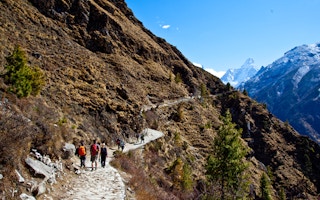At least 70 per cent of climbers have canceled their Mt. Everest expedition, officials said Saturday, as scientists warn climate change is causing the Himalayas to warm faster than the global average — making summiting the world’s tallest mountain increasingly dangerous.
The Nepalese government has failed in its attempts to persuade high-altitude guides to continue the climbing season since last Friday when an avalanche killed 16 mountain guides. Everest sits in the Himalayas near the border with China, about 100 miles east of Nepal’s capital, Kathmandu.
Officials said there were only 14-15 expedition groups left at the Everest base camp as of Saturday afternoon, and that remaining groups were packing. More than 39 groups with over 330 individuals had been issued government permits to climb, Nepali news agency, Kantipur, reported.
“Many groups have left the base camp on Saturday morning and the remaining ones are also seen packing,” the official told Kantipur, requesting anonymity. Nepali guides had decided to halt all expeditions, following the deaths of their co-workers.
“
A glacial lake downstream from Mt. Everest is now 13 times larger than it was 40 years ago — another sign of warming temperatures and melting ice
“After today’s meeting we have requested everyone here to stop climbing this season to honor all those who lost their lives and are still missing,” Tulsi Gurung, a local guide who has summited the mountain three times, told the Nepali Times Tuesday.
The Intergovernmental Panel on Climate Change (IPCC) warned last month that warming temperatures caused by man-made climate change have led to less predictable weather conditions worldwide – and the roof of the world is no exception.
Scientists said it’s impossible to link any one disaster to long-term changes in the global climate, but warned of increasing dangers in high-altitude areas. That means more avalanches, less stable climbing terrains, melting glaciers and storms of increasing intensity and frequency.
The Himalayas will likely see more snow as warming oceans will lead to more moisture during India’s annual monsoon season, which showers the 1,500-mile mountain range. Heavier snowstorms could lead to more accumulated snow — and a higher risk of avalanche.
“It’s Mother Nature who calls the shots,” Tim Rippel, an expedition leader, said in a blog post from Everest base camp. “The mountain has been deteriorating rapidly in the past three years due to global warming, and the breakdown in the Khumu Icefall is dramatic.”
Himalayan glaciers have shrunk by 21 per cent over the past three decades, according to the Kathmandu-based International Center for Integrated Mountain Development. A glacial lake downstream from Mt. Everest is now 13 times larger than it was 40 years ago — another sign of warming temperatures and melting ice.
Scientists were particularly surprised that the Himalayas were melting from the top — a sign of rising temperatures even at high elevations, Think Progress reported. Less snow at the top can lead to rock slides and more dangerous conditions for climbers, experts quoted by Think Progress said.
Global temperatures have risen 1.4 degrees Fahrenheit since the Industrial Revolution a century ago. Temperatures in the Himalayas, however, are warming at a rate up to three times that, the IPCC said.
“You can be sure that if the climate is changing — and it is — then glaciers are changing and the danger is shifting,” said US hydrologist Jeff Kargel of the University of Arizona. Kargel is leading a global project to measure and map the tens of thousands of Himalayan glaciers.
Warming temperatures could lead to an increase in melt water, which could cause glaciers to move more rapidly.
“Changes in snow and ice are going to strongly influence the stability of snow on a slope and the possibility of an avalanche,” said American glaciologist Tad Pfeffer with the Institute of Arctic and Alpine Research at the University of Colorado, Boulder.
“People will get in trouble if they rely on what they knew in the past. They have to have their eyes open and not go somewhere or do something simply because it worked out five years earlier.”










